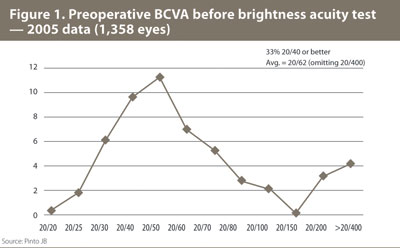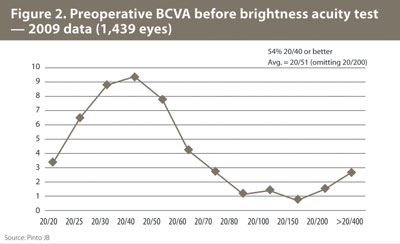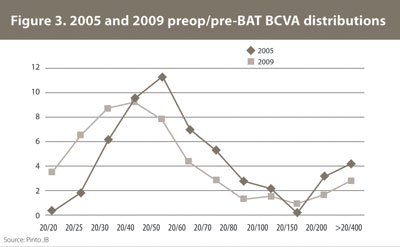Surgical assertiveness index shows shift from 5 years ago
An analysis shows that cataract surgeons have become more assertive in their case selection since 2005.
 John B. Pinto |
About 5 years ago in these pages, with much support from Drs. Richard Lindstrom and Elizabeth Davis, I reported client data showing the typical distribution curve for preoperative best corrected visual acuity before any brightness acuity testing, including two key statistics:
- The percentage of eyes with a preop/pre-Brightness Acuity Test (BAT) BCVA of 20/40 or better
- The average preop/pre-BAT acuity (omitting those eyes with a BCVA of 20/400 or worse, as a matter of convention for the study)
Back then, I looked at 1,358 eyes operated by 25 cataract surgeons — about 54 eyes each. The resulting distribution curve is seen in Figure 1.
 |
One-third of these eyes were 20/40 or better preop/pre-BAT, and the average Snellen acuity was 20/62, omitting those eyes with a BCVA of 20/400 or worse.
Since 2005, I have made these same calculations and generated the same distribution curves for scores of individual surgeons. In the first couple of years, aside from the occasional high and low values, subsequent surgeon data were much in line with the 2005 study. Most clients had about one-third of their patients presenting (pre-BAT) with a BCVA of 20/40 or better.
This benchmark has been a useful coaching tool. When the graph has been shifted sharply to the right (eg, when a client has a profile showing an average pre-BAT BCVA of 20/70), my typical advice has been for the surgeon to visit with a trusted colleague for some peer-to-peer insight on how to become a less reticent surgeon.
I have applied the same urgings for peer-to-peer discussions — in the opposite direction — for left-shifted surgeons, those whose pre-BAT BCVA profiles are 20/45 or lower. In such cases, where the client surgeon appears to be vastly more aggressive than average, I also recommend a redoubling of history taking, documentation and testing.
Is something changing?
Interestingly, I have observed that most client surgeons in the last year or two are “left-shifting,” becoming, on average, as assertive in their case selection as the most aggressive surgeons from 2005.
Here I present the most recent results, averaging the data from 28 client surgeons (an entirely different cohort from the 2005 study).
This time around, I looked at 1,439 eyes — about 51 eyes per surgeon. The resulting distribution curve is seen in Figure 2.
 |
 |
Compared with the 2005 study, 54% of eyes in the most recent study were 20/40 or better preop/pre-BAT, and the average Snellen acuity was 20/51, omitting the 20/400 and worse eyes. In Figure 3, the two curves are superimposed and combined into one graph.
Figure 4 presents another way of looking at the data from the two time frames.
 |
Unless this material graphical shift to the left is an artifact of the admittedly limited sample size in both studies, these data appear to signal a discernable change in surgeon behavior toward greater assertiveness in recent years. This shift is certainly in line with my subjective impression from visits to hundreds of practices over the past 5 years. Something interesting and not so subtle seems to be happening here.
As an “ophthalmologist-ologist,” I propose that this shift to the left could be driven by several possible factors, working alone or in combination:
- Rising surgeon confidence, resulting from lower complication rates, better methods, better tools and better education.
- A continued diffusion of best-practices knowledge in the profession. Over the last 40 years, cataract care has inexorably shifted from “Wait as long as you can,” to “Proceed whenever the patient is really ready,” to “Let’s just get on with it; the patient’s lifestyle enhancement is going to be terrific.”
- Rising surgeon-to-surgeon competition: “If I don’t help this patient today, my colleague down the road will operate on her tomorrow.”
- Greater demand from baby boomer patients, who are not only better informed and more finicky about their vision, but are increasingly concerned about future Medicare cuts.
- Ever-rising economic pressures on surgeons. If true, this is validation of the observation that utilization rises when fees fall, which will continue to null efforts to contain health care costs.
Evaluating your practice
Irrespective of the cause, this finding is helpful to report here for at least two reasons. First, as a placeholder for subsequent studies, and second, to teach you and your administrator a simple approach to measuring whether your practice is more or less conservative than those of your peers these days.
My interest in 2005 was driven by clients who would ask, “Am I a sufficiently assertive cataract surgeon? How do I stack up with other doctors?” The methodology I developed at the time was simple and, I will acknowledge here, probably less elegant than could be derived by better minds. Here it is for your own in-practice use:
1. Pull the last 50 cataract cases you have performed. Do not throw the data off by skipping cases you feel are unusual. We want a straight series of consecutive cases.
2. Simply write down in two columns the patient name or number (for subsequent reference if you are interested) and the preoperative BCVA before any brightness acuity testing.
3. Count the number of cases in each acuity category, and graph these counts, as in Figures 1 and 2.
4. Average the pre-BAT BCVA of these 50 cases, omitting those cases in which the visual acuity is 20/400 or worse. The resulting figure will probably be greater than 20/45 and less than 20/70.
5. Determine what percent of the 50 cases presented with 20/40 or better vision before surgery and without BAT testing. The resulting figure will typically be well under two-thirds.
6. If your curve is shifted materially to the left, you are a more aggressive surgeon and you may want to make sure your history taking, documentation and testing substantiates your case selection. If your curve is right-shifted, you are perhaps a less aggressive surgeon, and there may be an opportunity to help your patients by being a little more assertive.
Other observations
Here are a few additional observations in this interesting area:
- Providers in competitive urban markets, where the population-to-provider ratios are low, tend to have a lower average BCVA than noncompetitive markets.
- Higher-volume surgeons have a much lower average BCVA than low-volume surgeons.
- Surgeons working together in the same practice will commonly cluster — whether high, low or in the middle — with each other.
- Younger surgeons have a higher average BCVA and are more conservative than mid-career surgeons. Older surgeons tend to become more conservative once again in their 60s and beyond.
- Conservative surgeons, with a higher average preop BCVA, once exposed to their personal BCVA profile, often left-shift to become more assertive. Similarly, surgeons with much lower average preop BCVAs, whom one may politely call “very self-confident,” will often right-shift toward the mean when they see these data in black and white.
As I wrote in 2005, patterns of surgical aggressiveness or passivity tend to cut across the full span of clinical and surgical services. So, if through this exercise you find yourself to be a little less assertive in your cataract patterns than others, examine your utilization of other patient services as well. You may find that your use of special testing or return-to-clinic intervals could use an update.

- John B. Pinto is president of J. Pinto & Associates Inc., an ophthalmic practice management consulting firm established in 1979. Mr. Pinto is the country’s most published author on ophthalmology management topics. He is the author of John Pinto’s Little Green Book of Ophthalmology; Turnaround: 21 Weeks to Ophthalmic Practice Survival and Permanent Improvement; Cash Flow: The Practical Art of Earning More From Your Ophthalmology Practice; The Efficient Ophthalmologist: How to See More Patients, Provide Better Care and Prosper in an Era of Falling Fees; The Women of Ophthalmology; and his new book, Legal Issues in Ophthalmology: A Review for Surgeons and Administrators. He can be reached at 619-223-2233; e-mail: pintoinc@aol.com; Web site: www.pintoinc.com.
